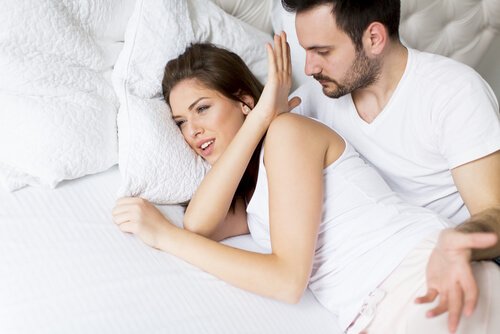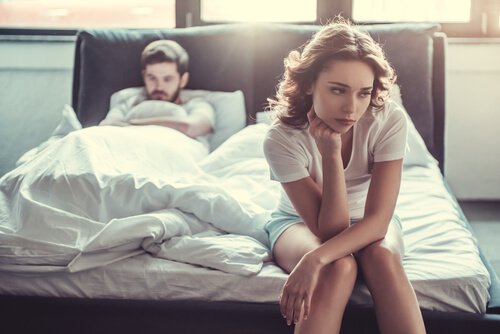When Women Lose Interest in Sex

If a woman isn’t interested in sex, it doesn’t mean she’s cold. There are many potential reasons for a lack of sexual desire. Maybe she simply isn’t in the mood, or there is a sexual dysfunction at play.
Women can lose sexual desire at any time. That is because female libido tends to fluctuate more than male libido. There are several studies that address this issue. One, from the Univesity of Turku in Finland, explains that these variations depend primarily on factors related to the romantic partner.
One of the causes of decreased sexual desire in women is female sexual arousal disorder. The Diagnostic and Statistical Manual of Mental Disorders (DSM-5) describes this disorder.
If a woman loses her sexual desire, is it considered a psychological disorder?
Women with female sexual arousal disorder experience a total lack of sexual desire. However, we have to keep in mind the interpersonal context of each particular woman.
A difference in desire, when the woman wants less sex than her partner, isn’t enough to diagnose a disorder. As we have seen before, the case might be that she simply doesn’t want as much sex as her partner. That doesn’t automatically mean that she has a pathology.

Criteria for diagnosing a female sexual arousal disorder
The DSM-5 proposes a series of criteria for evaluating and diagnosing this disorder. If the woman with low sexual desire doesn’t meet these criteria, she doesn’t have any kind of psychological disorder. Let’s take a look at the criteria.
A. Absence or significant reduction in female sexual interest or arousal. This manifests itself in at least one of the following ways:
- No interest, or reduced interest in sexual activity.
- The absence of, or a decrease in sexual or erotic fantasies and thoughts.
- Reduced or absent initiative in sexual activity. Regularly rejects the attempts of the romantic partner to initiate sexual activity.
- Lack of or reduced arousal or sexual pleasure during all or nearly all sexual activity with a partner (approx. 75-100%).
- Absent or reduced sexual arousal or pleasure in response to any sexual or erotic invitation, whether internal or external (i.e. written, verbal, visual…)
- Genital or non-genital sensations are absent or decreased during all or nearly all sexual activity (75-100%).
B. The symptoms of part A have persisted for a minimum of six months.
C. The symptoms of Part A cause significant clinical distress in the individual.
D. The sexual dysfunction isn’t due to a non-sexual mental disorder, nor is it the result of a serious change in the relationship (i.e. gender violence) or other significant stress factors. Nor can it be attributed to side effects of a medication, chemical substance, or other medical reason.
Different women, different ways of expressing low sexual desire
Different women can have different symptoms, just as different women express their sexuality and arousal in different ways. No two women are alike. For example, for one woman, sexual arousal disorder might mean a lack of interest in sexual activity. Add to that an absence of erotic or sexual thoughts and a reticence to initiate sexual activity or respond to sexual invitations. In another woman in the same stage of life, the main symptoms might be the inability to become sexually aroused. It also may mean she can’t respond to sexual stimuli with sexual desire. That means that any physical signs of sexual arousal are also absent.

Relationship problems can be a cause of sexual arousal disorder
Female sexual arousal disorder is often associated with a difficulty in achieving orgasm. It’s also related to pain during sex, infrequent sex, and an imbalance in sexual desire between two sexual partners.
Experts also associate relationship problems and mood disorders with this disorder. Expectations about sexual performance don’t help the situation. Society has unrealistic expectations about an appropriate level of sexual interest or arousal. Poor sexual techniques and lack of information about sexuality are also problematic.
These factors, along with common beliefs about gender roles, are important circumstances to keep in mind. The information that is out there, as well as sexual education from the past, can give people the wrong idea and mistaken expectations about sex.
Other causes that decrease female sexual desire
As we said earlier, we don’t have to catalog every problem as a disorder. The cause of decreased sexual desire might also be related to certain medications. Birth control pills and anti-depressants are two medications that can affect sexual desire.
But the root of the problem might be something more than what happens at the moment with her partner. It could be something other than the side-effect of medical treatment. Although this disorder is usually associated with premenopausal women, sexual dysfunction affects women of every age.
In the United States, approximately one-third of the female population suffers from sexual dysfunction, according to the University of Oklahoma Health Sciences Center. The Mayo Clinic also indicates that 40% of women will suffer sexual dysfunction at some point in their lives.
If you’re a woman in this situation (and you’re worried about it) we recommend you see a psychologist who specializes in sexual dysfunction. Only a professional will know how to help you. They can get you back to a comfortable level of sexual desire and improve your quality of life.
If a woman isn’t interested in sex, it doesn’t mean she’s cold. There are many potential reasons for a lack of sexual desire. Maybe she simply isn’t in the mood, or there is a sexual dysfunction at play.
Women can lose sexual desire at any time. That is because female libido tends to fluctuate more than male libido. There are several studies that address this issue. One, from the Univesity of Turku in Finland, explains that these variations depend primarily on factors related to the romantic partner.
One of the causes of decreased sexual desire in women is female sexual arousal disorder. The Diagnostic and Statistical Manual of Mental Disorders (DSM-5) describes this disorder.
If a woman loses her sexual desire, is it considered a psychological disorder?
Women with female sexual arousal disorder experience a total lack of sexual desire. However, we have to keep in mind the interpersonal context of each particular woman.
A difference in desire, when the woman wants less sex than her partner, isn’t enough to diagnose a disorder. As we have seen before, the case might be that she simply doesn’t want as much sex as her partner. That doesn’t automatically mean that she has a pathology.

Criteria for diagnosing a female sexual arousal disorder
The DSM-5 proposes a series of criteria for evaluating and diagnosing this disorder. If the woman with low sexual desire doesn’t meet these criteria, she doesn’t have any kind of psychological disorder. Let’s take a look at the criteria.
A. Absence or significant reduction in female sexual interest or arousal. This manifests itself in at least one of the following ways:
- No interest, or reduced interest in sexual activity.
- The absence of, or a decrease in sexual or erotic fantasies and thoughts.
- Reduced or absent initiative in sexual activity. Regularly rejects the attempts of the romantic partner to initiate sexual activity.
- Lack of or reduced arousal or sexual pleasure during all or nearly all sexual activity with a partner (approx. 75-100%).
- Absent or reduced sexual arousal or pleasure in response to any sexual or erotic invitation, whether internal or external (i.e. written, verbal, visual…)
- Genital or non-genital sensations are absent or decreased during all or nearly all sexual activity (75-100%).
B. The symptoms of part A have persisted for a minimum of six months.
C. The symptoms of Part A cause significant clinical distress in the individual.
D. The sexual dysfunction isn’t due to a non-sexual mental disorder, nor is it the result of a serious change in the relationship (i.e. gender violence) or other significant stress factors. Nor can it be attributed to side effects of a medication, chemical substance, or other medical reason.
Different women, different ways of expressing low sexual desire
Different women can have different symptoms, just as different women express their sexuality and arousal in different ways. No two women are alike. For example, for one woman, sexual arousal disorder might mean a lack of interest in sexual activity. Add to that an absence of erotic or sexual thoughts and a reticence to initiate sexual activity or respond to sexual invitations. In another woman in the same stage of life, the main symptoms might be the inability to become sexually aroused. It also may mean she can’t respond to sexual stimuli with sexual desire. That means that any physical signs of sexual arousal are also absent.

Relationship problems can be a cause of sexual arousal disorder
Female sexual arousal disorder is often associated with a difficulty in achieving orgasm. It’s also related to pain during sex, infrequent sex, and an imbalance in sexual desire between two sexual partners.
Experts also associate relationship problems and mood disorders with this disorder. Expectations about sexual performance don’t help the situation. Society has unrealistic expectations about an appropriate level of sexual interest or arousal. Poor sexual techniques and lack of information about sexuality are also problematic.
These factors, along with common beliefs about gender roles, are important circumstances to keep in mind. The information that is out there, as well as sexual education from the past, can give people the wrong idea and mistaken expectations about sex.
Other causes that decrease female sexual desire
As we said earlier, we don’t have to catalog every problem as a disorder. The cause of decreased sexual desire might also be related to certain medications. Birth control pills and anti-depressants are two medications that can affect sexual desire.
But the root of the problem might be something more than what happens at the moment with her partner. It could be something other than the side-effect of medical treatment. Although this disorder is usually associated with premenopausal women, sexual dysfunction affects women of every age.
In the United States, approximately one-third of the female population suffers from sexual dysfunction, according to the University of Oklahoma Health Sciences Center. The Mayo Clinic also indicates that 40% of women will suffer sexual dysfunction at some point in their lives.
If you’re a woman in this situation (and you’re worried about it) we recommend you see a psychologist who specializes in sexual dysfunction. Only a professional will know how to help you. They can get you back to a comfortable level of sexual desire and improve your quality of life.
This text is provided for informational purposes only and does not replace consultation with a professional. If in doubt, consult your specialist.







